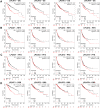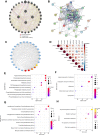Comprehensive Analysis of LPCATs Highlights the Prognostic and Immunological Values of LPCAT1/4 in Hepatocellular Carcinoma
- PMID: 34876845
- PMCID: PMC8643204
- DOI: 10.2147/IJGM.S344723
Comprehensive Analysis of LPCATs Highlights the Prognostic and Immunological Values of LPCAT1/4 in Hepatocellular Carcinoma
Abstract
Background: The prognosis of patients with advanced hepatocellular carcinoma (HCC) remains poor. Lipid remodeling modulators are considered promising therapeutic targets of cancers, owing to their functions of facilitating cancer cells' adaption to the limited environment. Lysophosphatidylcholine acyltransferases (LPCATs) are enzymes regulating bio-membrane remodeling, whose roles in HCC have not been fully illuminated.
Methods: Multiple bioinformatic tools were applied to comprehensively evaluate the expression, genetic alterations, clinical relevance, prognostic values, DNA methylation, biological functions, and correlations with immune infiltration of LPCATs in HCC.
Results: We found LPCAT1 was significantly overexpressed and the most frequently altered in HCC. The high-expression of LPCAT1/4 indicated clinicopathological advancements and poor prognoses of HCC patients. Even though the global DNA methylation of LPCATs in HCC showed no significant difference with that in normal liver, the hypermethylation of numerous CpG sites of them implied worse survivals of HCC patients. Thirty LPCATs' interactive genes were identified, which were generally membrane components and partook in phospholipid metabolism pathways. Finally, we found the expression of LPCATs was extensively positively correlated with the infiltration of various stimulatory and suppressive tumor-infiltrating immune cells (TIICs) in the tumor microenvironment.
Conclusion: This study addressed LPCAT1/4 were potential prognostic and immunotherapeutic biomarkers of HCC targeting bio-membrane lipid remodeling.
Keywords: LPCATs; bioinformatics; biomarker; hepatocellular carcinoma; immune infiltration.
© 2021 Lin et al.
Conflict of interest statement
The authors declare no conflict of interest in this work.
Figures







Similar articles
-
Pan-cancer analysis identifies LPCATs family as a prognostic biomarker and validation of LPCAT4/WNT/β-catenin/c-JUN/ACSL3 in hepatocellular carcinoma.Aging (Albany NY). 2023 May 23;15(11):4699-4713. doi: 10.18632/aging.204723. Epub 2023 May 23. Aging (Albany NY). 2023. PMID: 37294538 Free PMC article.
-
LPCAT1 acts as an independent prognostic biomarker correlated with immune infiltration in hepatocellular carcinoma.Eur J Med Res. 2022 Oct 28;27(1):216. doi: 10.1186/s40001-022-00854-1. Eur J Med Res. 2022. PMID: 36307879 Free PMC article.
-
Lysophosphatidylcholine acyltransferase 1 altered phospholipid composition and regulated hepatoma progression.J Hepatol. 2013 Aug;59(2):292-9. doi: 10.1016/j.jhep.2013.02.030. Epub 2013 Apr 6. J Hepatol. 2013. PMID: 23567080
-
ZWINT is a Promising Therapeutic Biomarker Associated with the Immune Microenvironment of Hepatocellular Carcinoma.Int J Gen Med. 2021 Oct 30;14:7487-7501. doi: 10.2147/IJGM.S340057. eCollection 2021. Int J Gen Med. 2021. PMID: 34744456 Free PMC article.
-
High expression of PDZ-binding kinase is correlated with poor prognosis and immune infiltrates in hepatocellular carcinoma.World J Surg Oncol. 2022 Jan 22;20(1):22. doi: 10.1186/s12957-021-02479-w. World J Surg Oncol. 2022. PMID: 35065633 Free PMC article.
Cited by
-
Integrated Proteomics and Metabolomics Analysis in Pregnant Rat Hippocampus After Circadian Rhythm Inversion.Front Physiol. 2022 Jul 22;13:941585. doi: 10.3389/fphys.2022.941585. eCollection 2022. Front Physiol. 2022. PMID: 35936909 Free PMC article.
-
ncRNA-Mediated High Expression of LPCAT1 Correlates with Poor Prognosis and Tumor Immune Infiltration of Liver Hepatocellular Carcinoma.J Immunol Res. 2022 May 16;2022:1584397. doi: 10.1155/2022/1584397. eCollection 2022. J Immunol Res. 2022. PMID: 35615532 Free PMC article.
-
Identification and validation of the fibrosis-related molecular subtypes of hepatocellular carcinoma by bioinformatics.Discov Oncol. 2025 Jun 23;16(1):1180. doi: 10.1007/s12672-025-02964-8. Discov Oncol. 2025. PMID: 40549259 Free PMC article.
References
LinkOut - more resources
Full Text Sources

